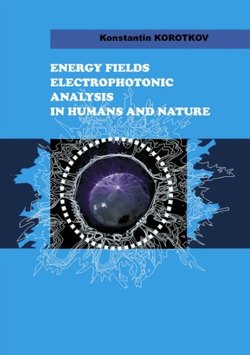Читать книгу Energy Fields Electrophotonic Analysis In Humans and Nature - Konstantin M.D. Korotkov - Страница 26
На сайте Литреса книга снята с продажи.
What is biological energy?
ОглавлениеThe main reservoir of free energy in biological processes is electron-excited states of complex molecular systems. Communities of delocalized excited π-electrons in protein macromolecules are the basis of this energy reservoir. Specific structural-protein complexes within the mass of the skin provide channels of heightened electron conductivity, measured at acupuncture points on the surface. These excited states are continuously supported at the expense of electron circulation in the biosphere. The main "working substance" is water and the energy source is the sun. A part of these electron excited states is expended for the support of current energy resources in the organism. A part can also be reserved for the future, as it happens in lasers after the absorption of the pump pulse.
The flow of impulse electrical current in non-conducting biological tissues might be provided by intermolecular transfer of excited electrons, using the mechanism of quantum tunnel effects, with the activated jump of electrons between macromolecules in the contact area. Thus, it can be assumed that the formation of specific structural-protein complexes within the mass of epidermis and dermis of the skin provides channels of heightened electron conductivity, which are experimentally measured as electrical conductance at acupuncture points on the surface of epidermis. Such channels can be theoretically present within the mass of connective tissue, which can be associated with “energy” meridians. In other words, the notion of “energy” transfer, characteristic of the ideas of Eastern medicine and alien to most people with a European education, might be associated with the transport of electron-excited states through molecular protein complexes. When physical or mental work is done in certain systems of the organism, electrons distributed in protein structures are transported within their given place and provide the process of oxidative phosphorylation, i.e. the energy supply for functioning of a local system. Thus, the organism forms an electron “energy depot,” supporting the current functioning and being the basis for work, at some moments requiring great resources or rapid flowing under conditions of extra-high loads -- typical, for example, of professional sport.
Stimulated impulse emission is also developed mainly by the transport of delocalized π-electrons, realized in electrically non-conducting tissue by way of the quantum electron tunnel mechanism. This proposition allows an assumption that the EPI technique provides indirect judgment about the level of energy resources at the molecular level of functioning in structural-protein complexes. (see Korotkov K., Williams B., Wisneski L. Biophysical Energy Transfer Mechanisms in Living Systems: The Basis of Life Processes. J of Alternative and Complementary Medicine, 2004, 10, 1, 49-57).
